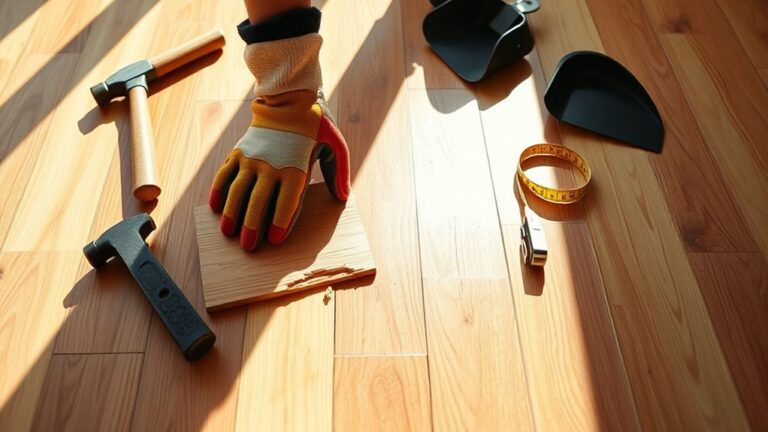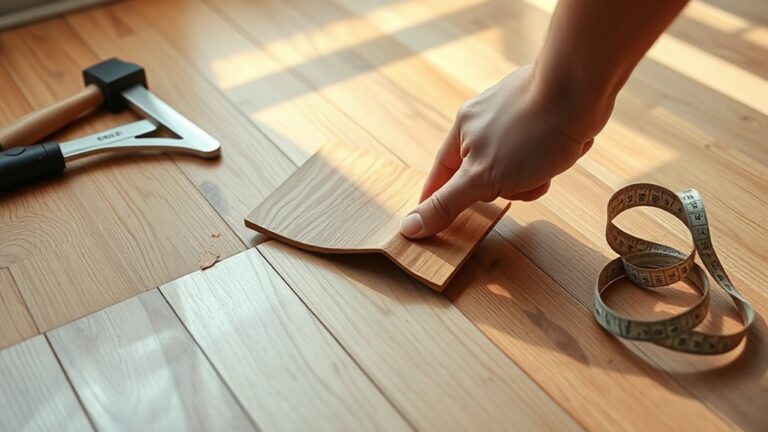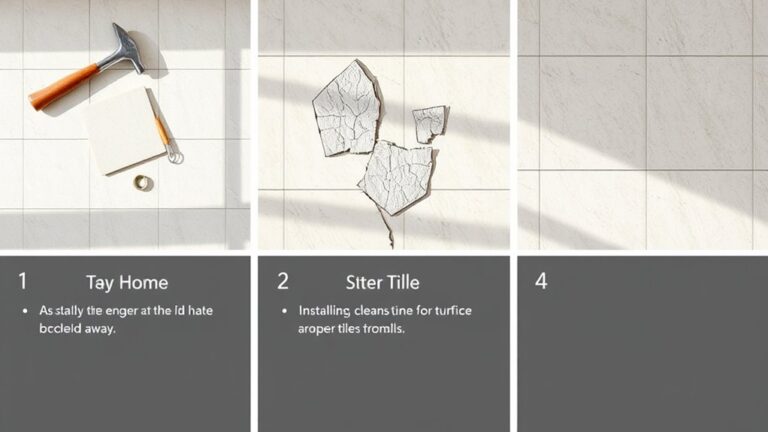To seal natural stone floors, start by cleaning the surface thoroughly with a pH-neutral cleaner and allowing it to dry completely for 12-24 hours. Remove any furniture and inspect for moisture absorption in the grout. Choose a suitable sealant based on the stone type and perform a test application. Apply 2-3 thin coats using the appropriate rollers, ensuring even coverage and allowing adequate drying time between each coat. After sealing, let the floor cure for 36-48 hours before replacing furniture. Regular maintenance is key to preserving your stone's beauty and durability, and there's more to explore about care techniques.
Preparation and Cleaning Process
Preparing and cleaning your natural stone floors is vital for achieving a successful seal. Start by sweeping or vacuuming the surface to eliminate dust and debris. This preparation step is important, as it guarantees the cleaning process is effective and the sealing stone adheres properly.
Next, mix a cleaning agent like Lithofin or HG products with hot water in small batches. This solution will help scrub away dirt and grime effectively. Wet the area with your cleaning mixture, and while it's still wet, scrub the grout thoroughly. This prevents the solution from drying on the surface, which could lead to residue and staining.
After scrubbing, rinse the floor with clean hot water. It's important to remove all cleaning agents to avoid any interference with the sealing process. Once rinsed, dry the floor using clean cloths or mops. Allow the stone to dry for 12-24 hours; this step is critical as any moisture left can compromise the seal.
If you encounter deep stains, address them with stronger cleaning solutions or specialized products before sealing. This guarantees the best appearance of your stone floors once the sealing is applied. By following these steps, you'll achieve a well-prepared and clean surface, setting the stage for a successful sealing process that enhances the beauty and longevity of your natural stone floors.
Pre-Sealing Preparation
After guaranteeing your natural stone floors are clean and dry, it's time to focus on pre-sealing preparation. First, remove all items from the floor area and allow the stone to dry completely overnight. This step is essential, as any remaining moisture can hinder the sealing process. Once dried, inspect grout joints for moisture absorption. If you notice any retained moisture, it's best to address this before proceeding, as it could compromise the seal.
Next, thoroughly sweep or vacuum the stone flooring to eliminate dust and debris. These particles can interfere with the adhesion of the sealant, leading to uneven coverage and potential failure of the seal. After cleaning, gather all necessary tools and materials for an efficient sealing process. You'll need a flat mop, a soft bristle brush, rubber gloves, microfiber cloths, a mixing container, and dust sheets to protect surrounding areas.
Before you begin applying the sealant, be sure to read the product instructions carefully. Familiarizing yourself with the guidelines guarantees that you'll use the sealant effectively, achieving ideal results in sealing your natural stone. By completing this pre-sealing preparation, you set the stage for a successful sealing process that will protect and enhance the beauty of your stone flooring for years to come.
Selecting and Testing Seal
Choosing the right sealant is essential for guaranteeing the longevity and beauty of your natural stone floors. When selecting a sealant, you need to take into account the specific characteristics and porosity of your stone tiles to guarantee compatibility and effectiveness in sealing natural stone. Here are four key steps to guide you through the selection and testing process:
- Assess the Type of Stone: Different types of stone have varying levels of porosity, which affects how they absorb sealants. Research your specific stone type to find the most suitable product.
- Consult Local Suppliers: Speak to local suppliers or installation companies for recommendations on sealants that work best for your type of stone. They often have valuable insights based on experience.
- Perform a Test Application: Before committing to a full application, apply the cleaner first, then test the sealant on a small area or spare tile. This allows you to evaluate the sealant's appearance and absorption.
- Monitor Drying Time: After the initial coat, observe the stone's absorption. Depending on how the stone reacts, you may need multiple coats for the desired finish. Be sure to allow adequate drying time between coats, typically several hours, and inspect for bubbles to guarantee an even application.
Sealing Process
Once you've selected and tested an appropriate sealant, it's time to put that knowledge into action and begin the sealing process. Start by thoroughly cleaning the stone floor with a suitable pH-neutral cleaner. This step is vital, as it removes dirt and residues that could interfere with the sealer product's effectiveness.
When you're ready to apply the sealer, use a short pile roller for honed marble or limestone and a sponge roller for riven slate. Work in small sections, roughly one square meter at a time, to guarantee better control and even coverage. Apply 2-3 thin coats of sealer, allowing adequate drying time between each coat. As you apply, monitor for any bubbles that may form, smoothing them out immediately to maintain an even finish.
Verify the first coat is absorbed properly into the stone. If you notice the sealant sitting on the surface, work it in to prevent uneven drying. This will help maintain a consistent look across your floor. After completing the application, let the floor dry for 36-48 hours before walking on it. It's important to check for any tackiness to confirm full curing before moving furniture back into place. Following these steps will guarantee your natural stone floor is well protected and looks its best for years to come.
Post-Sealing Care
Proper post-sealing care is essential for maintaining the longevity and appearance of your natural stone floor. After sealing, you must allow the floor to dry completely before walking on it to avoid disrupting the curing process. Check for any tackiness before stepping onto the surface. Here are four key maintenance steps to follow:
- Wait Before Replacing Furniture: Hold off on putting furniture back for 36-48 hours. This guarantees the sealant has fully cured and bonded with the stone, preventing any damage.
- Address Spills Immediately: If any spills occur, use a dry soft cloth to blot the area immediately. Avoid rubbing, as this can spread the liquid and worsen the stain.
- Monitor Appearance Changes: Be aware that the appearance of the sealed stone may change after 24 hours. Familiarize yourself with how the sealant looks when dry, as this will help you maintain its ideal appearance.
- Touch Up as Needed: If you notice any affected areas from spills, touch them up with a small amount of sealant. This will help maintain an even appearance across your floor.
Frequently Asked Questions
Should You Seal Natural Stone Floors?
Yes, you should seal natural stone floors for their protection and longevity. The benefits include preventing stains and enhancing appearance. Depending on the stone type, sealing frequency varies—highly porous stones need it every six months, while granite requires it annually. For DIY sealing tips, always choose the best sealant types, whether surface or penetrating. Regular stone maintenance practices not only improve aesthetics but also reduce environmental impact, ensuring a hygienic living space.
How Do You Seal Nature Stone Floors?
To seal natural stone floors, start by identifying your stone types and selecting suitable sealing products. Clean the surface thoroughly, then apply the sealant using proper application techniques, ensuring it soaks in for 5-10 minutes. Avoid common mistakes like applying too much or not buffing excess properly. Allow adequate drying time, typically 24-48 hours between coats. Consider cost factors, and remember regular maintenance is key for lasting protection and appearance.
How Do You Clean and Seal a Natural Stone Floor?
So you think cleaning and sealing a natural stone floor's a walk in the park? Think again! Start with effective stone cleaning techniques, scrubbing away those common stone stains. When it's time to seal, consider a sealing products comparison to find what works for you. DIY sealing tips can save you cash, but don't shy away from professional sealing services if you need expert help. Remember the sealing frequency guidelines for proper natural stone maintenance!
What Happens if You Don't Seal Natural Stone Tile?
If you don't seal natural stone tile, you'll face issues like increased stone absorption, leading to moisture damage and stain penetration from spills. Without a protective layer, surface degradation occurs quickly, requiring higher maintenance frequency. The longevity benefits of sealing products can't be overstated; they prevent permanent stains and extend the life of your stone. Ultimately, neglecting to seal can compromise both the aesthetic and structural integrity of your natural stone surfaces.




